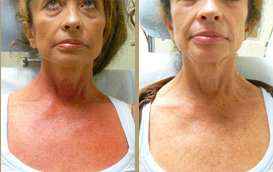Poikiloderma is a skin condition whose preliminary cause remains unknown. It’s characterized by changes in color of the skin and skin texture. The discolored spots differ in color but are usually shades of brown and red. It usually occurs on the cheeks, neck and chest. The condition is categorized hyperpigmentation, hypopigmentation, discoloration spots, thinning skin and telangiectasia.
Hyperpigmentation is the darker skin coloration, hypopigmentation is the lighter skin coloration and telangiectasia is the appearance of blood vessels. There are also three types of poikiloderma:
- Poikiloderma vasculare atrophicans
- Poikiloderma of Civatte
- Hereditary sclerosing poikiloderma
A board certified dermatologist should evaluate signs of poikiloderma to correctly identify the type and determine if the condition needs treatment. Additionally, several underlying disorders may cause poikiloderma. More often than not, people with poikiloderma seek cosmetic treatment due to its splotchy appearance. Poikiloderma may also result in the skin affected itching, burning or hurting.

Poikiloderma is categorized hyperpigmentation, hypopigmentation, discoloration spots, thinning skin and telangiectasia. Before (left) and after (right) the patient was treated for the condition.*
POIKILODERMA OF CIVATTE POTENTIAL CAUSES
Poikiloderma of Civatte is thought to occur from cumulative sun exposure and possibly also genetic. While it occurs in both sexes, it is more prevalent in menopausal and postmenopausal women. This suggests that is may be linked to hormonal changes and aging. Another possibility is poikiloderma of Civatte is a photoallergic reaction from fragrances and sun exposure.
TREATMENT OPTIONS FOR POIKILODERMA OF CIVATTE
Treatment of poikiloderma of Civatte is difficult and must address both the blood vessels and pigmentation discrepancies. Photodynamic therapy (PDT) and lasers are usually the most effective treatment of it cosmetically. Other methods include bleaching creams, chemical peels and electrodessication. Additionally, limiting sun exposure and continuous sunscreen use may be one of the best preventions.
VBeam and Fraxel
Lasers usually work the best since light energy penetrates the skin’s surface to remove imperfections and heal without the appearance of poikiloderma. The VBeam
PDT is used with Levulan, a topical photosensitizer applied 30 to 45 minutes prior to each therapy. The treatment uses a 585 – 595 nanometer laser to seal off blood vessels, which eliminated the appearance of redness and telangiactasia.
Fractional photothermolysis with Fraxel lasers is also effective. Pigmentation is broken up while new collagen fibers form.
With any skin condition, consult with a physician or dermatologist to plan a course of treatment.
